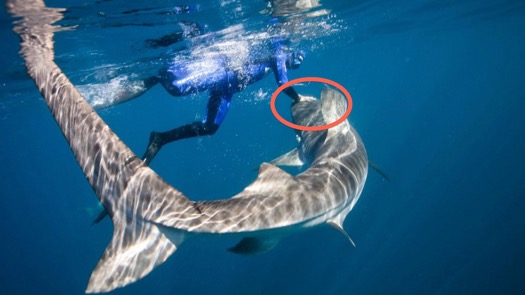How to Defend Against a Shark Attack

Most people think they are done for if a shark initiates an attack. However, there are many things that swimmers can do in order to beat back and potentially discourage a shark from attacking. Looking at some of the tips below shows us that we have options, even in a situation where it seems the predator has the upper hand.
Maximize Your Profile
Sharks recognize small and large targets, and they tend to prefer to go for ones that will present less of a challenge. If you find yourself face to face with an aggressive shark, do what you can to make yourself look as big and formidable as possible. This is your first line of defense against an attack, and you will be surprised to know that many sharks will simply turn away if they think that you’re not worth the trouble.
Don’t Play Dead
The last thing that you want to do is to play dead or go limp when a shark is coming at you. Remember that sharks tend to go for the weaker prey, and injured or dying fish are prime targets. This is why they are so attracted to the smell of blood in the water, and can detect it from miles away. They think that they are getting an easy meal. Do what you can to thrash, splash, scream, kick your legs and wave your hands. The more lively you are, the less the shark will be inclined to attack.
Fight Back
Sharks don’t expect prey to hit, claw, pull or jab at them while they are being attacked. Sharks actually have a number of sensitive areas on their body that will cause them great discomfort if struck. The most sensitive, and arguably effective, is their snout. If you can give the shark a repeated banging on the top of their mouth and nose, it has an effect similar to getting kneed in the testicles. You can also aim directly at the tip of their nose. Getting struck here hurts a lot, and many sharks will turn tail and run once this happens. However, you may need to repeatedly strike the shark, particularly one who is fixated on the attack before they will break off.
Other sensitive areas of the shark are around the gills and eyes. Use any gear that can serve as a blunt object or your bare hands and fists if all else fails. Hit fast, hit hard, and hit repeatedly. Keep striking, gouging or grabbing these areas until the shark stops the attack.
Get to Shore
Once the attack has broken off, get to shore or in your boat as quickly as possible. The fight, as well as your blood will attract other sharks to the area. You do not want to delay getting out of the water, controlling bleeding and attending to injuries. Even if you are not injured, you want to get out of the area, and the safest place is out of the water altogether.
Preventive Steps
The best way to avoid getting attacked is to reduce the risk in the first place. Don’t swim in waters known to have shark activity. Don’t swim if you are bleeding or injured. Don’t swim at night because you can’t see sharks coming at you. Don’t swim near where rivers or other bodies of water meet the sea. This is prime hunting ground for sharks who are looking for a meal in fish-rich waters.
Finally, avoid wearing jewelry or anything that glitters or reflects sunlight. Sharks often confuse this with the light reflecting off of the scales of fish. Remember that many shark attacks are spurred by a case of mistaken identity, and you don’t want to do anything to encourage an accident from happening.
While there are no guarantees that these techniques will work in every situation, they have been proven to be successful in many attacks. Remember, you never want to give up without a fight, and you can definitely fight back a shark attack.


